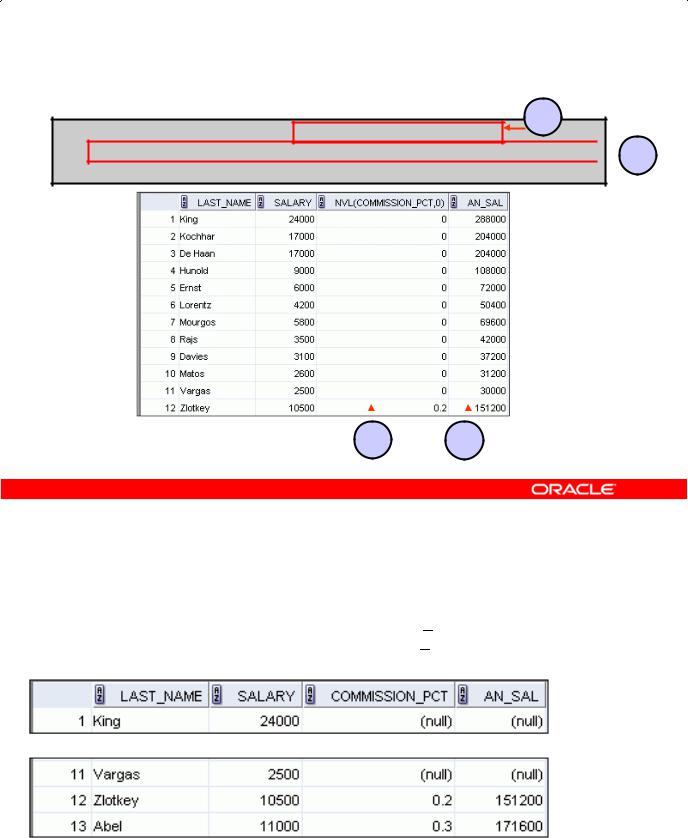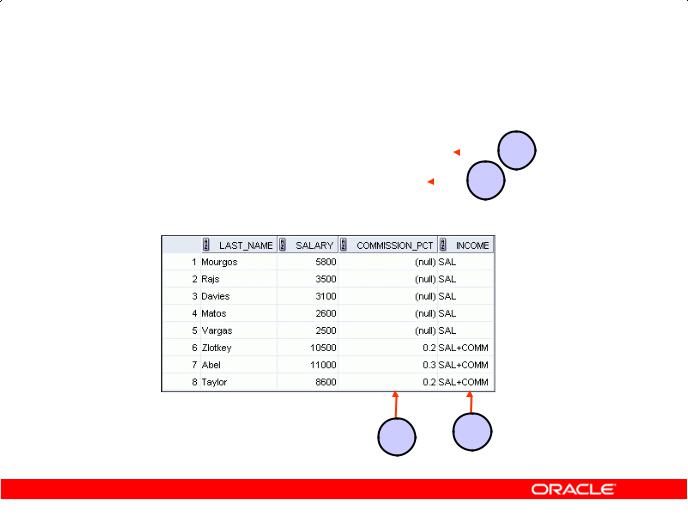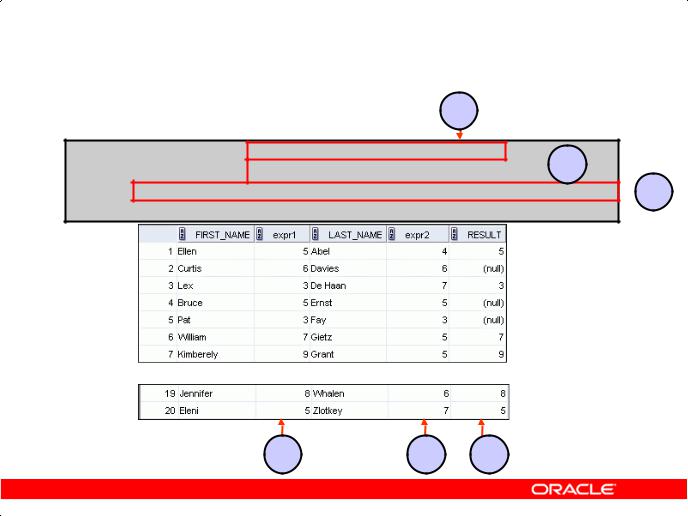
- •Preface
- •Introduction
- •Lesson Objectives
- •Lesson Agenda
- •Course Objectives
- •Course Agenda
- •Appendixes Used in the Course
- •Lesson Agenda
- •Oracle Database 11g: Focus Areas
- •Oracle Database 11g
- •Oracle Fusion Middleware
- •Oracle Enterprise Manager Grid Control 10g
- •Oracle BI Publisher
- •Lesson Agenda
- •Relational and Object Relational Database Management Systems
- •Data Storage on Different Media
- •Relational Database Concept
- •Definition of a Relational Database
- •Data Models
- •Entity Relationship Model
- •Relating Multiple Tables
- •Relational Database Terminology
- •Lesson Agenda
- •Using SQL to Query Your Database
- •SQL Statements
- •Development Environments for SQL
- •Lesson Agenda
- •The Human Resources (HR) Schema
- •Tables Used in the Course
- •Lesson Agenda
- •Oracle Database 11g Documentation
- •Additional Resources
- •Summary
- •Practice I: Overview
- •Objectives
- •Lesson Agenda
- •Capabilities of SQL SELECT Statements
- •Basic SELECT Statement
- •Selecting All Columns
- •Selecting Specific Columns
- •Writing SQL Statements
- •Column Heading Defaults
- •Lesson Agenda
- •Arithmetic Expressions
- •Using Arithmetic Operators
- •Operator Precedence
- •Defining a Null Value
- •Null Values in Arithmetic Expressions
- •Lesson Agenda
- •Defining a Column Alias
- •Using Column Aliases
- •Lesson Agenda
- •Concatenation Operator
- •Literal Character Strings
- •Using Literal Character Strings
- •Alternative Quote (q) Operator
- •Duplicate Rows
- •Lesson Agenda
- •Displaying the Table Structure
- •Using the DESCRIBE Command
- •Quiz
- •Summary
- •Practice 1: Overview
- •Objectives
- •Lesson Agenda
- •Limiting Rows Using a Selection
- •Limiting the Rows That Are Selected
- •Using the WHERE Clause
- •Character Strings and Dates
- •Comparison Operators
- •Using Comparison Operators
- •Range Conditions Using the BETWEEN Operator
- •Membership Condition Using the IN Operator
- •Pattern Matching Using the LIKE Operator
- •Combining Wildcard Characters
- •Using the NULL Conditions
- •Defining Conditions Using the Logical Operators
- •Using the AND Operator
- •Using the OR Operator
- •Using the NOT Operator
- •Lesson Agenda
- •Rules of Precedence
- •Lesson Agenda
- •Using the ORDER BY Clause
- •Sorting
- •Lesson Agenda
- •Substitution Variables
- •Using the Single-Ampersand Substitution Variable
- •Character and Date Values with Substitution Variables
- •Specifying Column Names, Expressions, and Text
- •Using the Double-Ampersand Substitution Variable
- •Lesson Agenda
- •Using the DEFINE Command
- •Using the VERIFY Command
- •Quiz
- •Summary
- •Practice 2: Overview
- •Objectives
- •Lesson Agenda
- •SQL Functions
- •Two Types of SQL Functions
- •Single-Row Functions
- •Lesson Agenda
- •Character Functions
- •Case-Conversion Functions
- •Using Case-Conversion Functions
- •Character-Manipulation Functions
- •Using the Character-Manipulation Functions
- •Lesson Agenda
- •Number Functions
- •Using the ROUND Function
- •Using the TRUNC Function
- •Using the MOD Function
- •Lesson Agenda
- •Working with Dates
- •RR Date Format
- •Using the SYSDATE Function
- •Arithmetic with Dates
- •Using Arithmetic Operators with Dates
- •Lesson Agenda
- •Date-Manipulation Functions
- •Using Date Functions
- •Using ROUND and TRUNC Functions with Dates
- •Quiz
- •Summary
- •Practice 3: Overview
- •Objectives
- •Lesson Agenda
- •Conversion Functions
- •Implicit Data Type Conversion
- •Explicit Data Type Conversion
- •Lesson Agenda
- •Using the TO_CHAR Function with Dates
- •Elements of the Date Format Model
- •Using the TO_CHAR Function with Dates
- •Using the TO_CHAR Function with Numbers
- •Using the TO_NUMBER and TO_DATE Functions
- •Using the TO_CHAR and TO_DATE Function with RR Date Format
- •Lesson Agenda
- •Nesting Functions
- •Lesson Agenda
- •General Functions
- •NVL Function
- •Using the NVL Function
- •Using the NVL2 Function
- •Using the NULLIF Function
- •Using the COALESCE Function
- •Lesson Agenda
- •Conditional Expressions
- •CASE Expression
- •Using the CASE Expression
- •DECODE Function
- •Using the DECODE Function
- •Quiz
- •Summary
- •Practice 4: Overview
- •Objectives
- •Lesson Agenda
- •What Are Group Functions?
- •Types of Group Functions
- •Group Functions: Syntax
- •Using the AVG and SUM Functions
- •Using the MIN and MAX Functions
- •Using the COUNT Function
- •Using the DISTINCT Keyword
- •Group Functions and Null Values
- •Lesson Agenda
- •Creating Groups of Data
- •Creating Groups of Data: GROUP BY Clause Syntax
- •Using the GROUP BY Clause
- •Grouping by More than One Column
- •Using the GROUP BY Clause on Multiple Columns
- •Illegal Queries Using Group Functions
- •Restricting Group Results
- •Restricting Group Results with the HAVING Clause
- •Using the HAVING Clause
- •Lesson Agenda
- •Nesting Group Functions
- •Quiz
- •Summary
- •Practice 5: Overview
- •Objectives
- •Lesson Agenda
- •Types of Joins
- •Joining Tables Using SQL:1999 Syntax
- •Qualifying Ambiguous Column Names
- •Lesson Agenda
- •Creating Natural Joins
- •Retrieving Records with Natural Joins
- •Creating Joins with the USING Clause
- •Joining Column Names
- •Retrieving Records with the USING Clause
- •Using Table Aliases with the USING Clause
- •Creating Joins with the ON Clause
- •Retrieving Records with the ON Clause
- •Creating Three-Way Joins with the ON Clause
- •Applying Additional Conditions to a Join
- •Lesson Agenda
- •Joining a Table to Itself
- •Self-Joins Using the ON Clause
- •Lesson Agenda
- •Nonequijoins
- •Retrieving Records with Nonequijoins
- •Lesson Agenda
- •INNER Versus OUTER Joins
- •LEFT OUTER JOIN
- •RIGHT OUTER JOIN
- •FULL OUTER JOIN
- •Lesson Agenda
- •Cartesian Products
- •Generating a Cartesian Product
- •Creating Cross Joins
- •Quiz
- •Summary
- •Practice 6: Overview
- •Objectives
- •Lesson Agenda
- •Using a Subquery to Solve a Problem
- •Subquery Syntax
- •Using a Subquery
- •Guidelines for Using Subqueries
- •Types of Subqueries
- •Lesson Agenda
- •Single-Row Subqueries
- •Executing Single-Row Subqueries
- •Using Group Functions in a Subquery
- •The HAVING Clause with Subqueries
- •What Is Wrong with This Statement?
- •No Rows Returned by the Inner Query
- •Lesson Agenda
- •Multiple-Row Subqueries
- •Lesson Agenda
- •Null Values in a Subquery
- •Quiz
- •Summary
- •Practice 7: Overview
- •Objectives
- •Lesson Agenda
- •Set Operators
- •Set Operator Guidelines
- •The Oracle Server and Set Operators
- •Lesson Agenda
- •Tables Used in This Lesson
- •Lesson Agenda
- •UNION Operator
- •Using the UNION Operator
- •UNION ALL Operator
- •Using the UNION ALL Operator
- •Lesson Agenda
- •INTERSECT Operator
- •Using the INTERSECT Operator
- •Lesson Agenda
- •MINUS Operator
- •Using the MINUS Operator
- •Lesson Agenda
- •Matching the SELECT Statements
- •Matching the SELECT Statement: Example
- •Lesson Agenda
- •Using the ORDER BY Clause in Set Operations
- •Quiz
- •Summary
- •Practice 8: Overview

NVL Function
Converts a null value to an actual value:
•Data types that can be used are date, character, and number.
•Data types must match:
–NVL(commission_pct,0)
–NVL(hire_date,'01-JAN-97')
–NVL(job_id,'No Job Yet')
Copyright © 2009, Oracle. All rights reserved.
NVL Function |
|
|
Academy |
||
|
|
|
|
||
To convert a null value to an actual value, use the NVL function. |
|||||
Syntax |
|
Oracle |
|||
NVL (expr1, expr2) |
|||||
In the syntax: |
|
||||
|
|
|
|||
|
• expr1 is the source value or expression that may co tain a null |
||||
|
|
|
& |
|
|
|
• expr2 is the target value for converting the null |
||||
|
|
|
|
Only |
|
You can use the NVL function to co vert any data type, but the return value is always the same as the |
|||||
data type of expr1. |
|
|
|
||
NVL Conversions for Various Data Types |
|
|
|||
|
|
|
Use |
||
|
|
Internal |
|
|
|
|
Data Type |
|
Conversion Example |
|
|
|
|
|
|
|
|
|
NUMBER |
|
NVL(number_column,9) |
|
|
|
|
|
|
|
|
|
DATE |
|
NVL(date_column, '01-JAN-95') |
|
|
|
Oracle |
|
|
||
|
CHAR or VARCHAR2 |
NVL(character_column, 'Unavailable') |
|
||
|
|
|
|
|
|
Oracle Database 11g: SQL Fundamentals I 4 - 28

Using the NVL Function
1
SELECT last_name, salary, NVL(commission_pct, 0),
(salary*12) + (salary*12*NVL(commission_pct, 0)) AN_SAL 2 FROM employees;
2 FROM employees;
|
|
… |
|
|
|
|
|
|
|
|
|
1 |
|
|
|
||
|
|
|
2 |
Academy |
||||
|
|
|
|
|||||
|
|
|
|
|
||||
|
|
Copyright © 2009, Oracle. All rights reserved. |
|
|||||
Using the NVL Function |
Oracle |
|||||||
|
|
FROM employees; |
||||||
|
To calculate the annual compensation of all employees, you need to multiply the monthly salary by |
|||||||
|
12 and then add the commission percentage to the result: |
|
|
|
||||
|
|
SELECT last_name, salary, commission pct, |
|
|||||
|
|
(salary*12) + (salary*12*commission pct) AN_SAL |
||||||
|
|
|
& |
Only |
|
|||
|
|
Internal |
|
|
|
|
|
|
|
… |
|
Use |
|
|
|
||
|
|
|
|
|
|
|
|
|
Oracle |
|
|
|
|
|
|
||
|
… |
|
|
|
|
|
|
|
Notice that the annual compensation is calculated for only those employees who earn a commission. If any column value in an expression is null, the result is null. To calculate values for all employees, you must convert the null value to a number before applying the arithmetic operator. In the example in the slide, the NVL function is used to convert null values to zero.
Oracle Database 11g: SQL Fundamentals I 4 - 29

Using the NVL2 Function
|
|
|
|
|
|
|
|
|
SELECT |
last_name, salary, |
commission_pct, |
|
|
|
1 |
||
|
|
|
||||||
|
NVL2(commission_pct, |
|
|
|
2 |
|
||
FROM |
'SAL+COMM', 'SAL') income |
|
|
|
|
|
||
employees WHERE department_id IN (50, 80); |
||||||||
1 |
2 |
|
|
Copyright © 2009, Oracle. All rights reserved. |
|
Using the NVL2 Function |
Academy |
|
Syntax |
NVL2(expr1, expr2, expr3) Oracle |
|||
In the syntax: |
|
& |
|
|
• expr1 is the source value or expression that may contain a null |
||||
• expr2 is the value that is retur |
|
Only |
||
ed if expr1 is not null |
||||
• expr3 is the value that is eturned if expr1 is null |
||||
|
|
|
Use |
|
|
|
Internal |
|
|
The NVL2 function examines the first expression. If the first expr ssion is not null, then the NVL2 function returns the second expression. If the first expression is null, then the third expression is returned.
In the example shown in he slide, the COMMISSION_PCT column is examined. If a value is
detected, the text literal value of SAL+COMM is returned. If the COMMISSION_PCT column contains
Oraclea null value, the t xt literal value of SAL is returned.
Notes: The argument expr1 can have any data type. The arguments expr2 and expr3 can have any d ta types except LONG.
Oracle Database 11g: SQL Fundamentals I 4 - 30

Using the NULLIF Function
1
SELECT first_name, LENGTH(first_name) "expr1", last_name, LENGTH(last_name) "expr2",  2
2
NULLIF(LENGTH(first_name), LENGTH(last_name)) result 3
3
FROM
1 |
2 |
3 |
Copyright © 2009, Oracle. All rights reserved. |
Academy |
|
Using the NULLIF Function |
|
|
The NULLIF function compares two expressions.OracleIf they are equa , the function returns a null. If
they are not equal, the function returns the first expression. However, you cannot specify the literal NULL for the first expression.
Syntax
NULLIF (expr1, expr2) |
& |
|
|
In the syntax: |
Only |
to the length of theInternallast name in the EMPLOYEES table. When the lengths of the names are equal, a
• NULLIF compares expr1 and expr2. If th y are equal, then the function returns null. If they
are not, then the function etur s expr1. How ver, you cannot specify the literal NULL for
expr1. |
Use |
|
In the example shown in the slide, the length of the first name in the EMPLOYEES table is compared
Oraclenull value is displayed. When the lengths of the names are not equal, the length of the first name is displ yed.
Note: The NULLIF function is logically equivalent to the following CASE expression. The CASE expression is discussed on a subsequent page:
CASE WHEN expr1 = expr 2 THEN NULL ELSE expr1 END
Oracle Database 11g: SQL Fundamentals I 4 - 31
